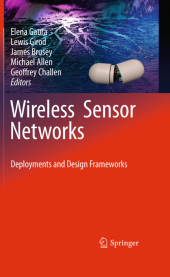 Neuerscheinungen 2014Stand: 2020-02-01 |
Schnellsuche
ISBN/Stichwort/Autor
|
Herderstraße 10
10625 Berlin
Tel.: 030 315 714 16
Fax 030 315 714 14
info@buchspektrum.de |

Michael Allen, James Brusey, Geoffrey Challen, Elena Gaura, Lewis Girod
(Beteiligte)
Wireless Sensor Networks
Deployments and Design Frameworks
Herausgegeben von Gaura, Elena; Girod, Lewis; Brusey, James; Allen, Michael; Challen, Geoffrey
2010. 2014. xvi, 290 S. 235 mm
Verlag/Jahr: SPRINGER, BERLIN; SPRINGER US; SPRINGER 2014
ISBN: 1-489-99058-5 (1489990585)
Neue ISBN: 978-1-489-99058-7 (9781489990587)
Preis und Lieferzeit: Bitte klicken
The most successful and up-to-date wireless sensor network applications are presented in this volume, and are discussed in terms of practical design, implementation, deployment and more. The text provides a design framework suitable for rapid development.
The twentieth century ended with the vision of smart dust: a network of wirelessly connected devices whose size would match that of a dust particle, each one a se- containedpackageequippedwithsensing,computation,communication,andpower. Smart dust held the promise to bridge the physical and digital worlds in the most unobtrusive manner, blending together realms that were previously considered well separated. Applications involved scattering hundreds, or even thousands, of smart dust devices to monitor various environmental quantities in scenarios ranging from habitat monitoring to disaster management. The devices were envisioned to se- organize to accomplish their task in the most ef?cient way. As such, smart dust would become a powerful tool, assisting the daily activities of scientists and en- neers in a wide range of disparate disciplines. Wireless sensor networks (WSNs), as we know them today, are the most no- worthy attempt at implementing the smart dust vision. In the last decade, this ?eld has seen a fast-growing investment from both academia and industry. Signi?cant ?nancial resources and manpower have gone into making the smart dust vision a reality through WSNs. Yet, we still cannot claim complete success. At present, only specialist computerscientists or computerengineershave the necessary background to walk the road from conception to a ?nal, deployed, and running WSN system.
Wireless Sensor Networks Design for Deployment.- Learning from Deployment Experience.- Designing for Deployment.- Wireless Sensor Network Applications Case Studies.- Volcano Monitoring: Addressing Data Quality Through Iterative Deployment.- VoxNet: Reducing Latency in High Data Rate Applications.- Failure Is Inevitable: The Trade-off Between Missing Data and Maintenance.- Cane Toad Monitoring: Data Reduction in a High Rate Application.- ExScal: Dealing with Scale.- Glacier Monitoring: Deploying Custom Hardware in Harsh Environments.- Adding the Human Element: Experience with a Wireless Patient Monitoring System.


